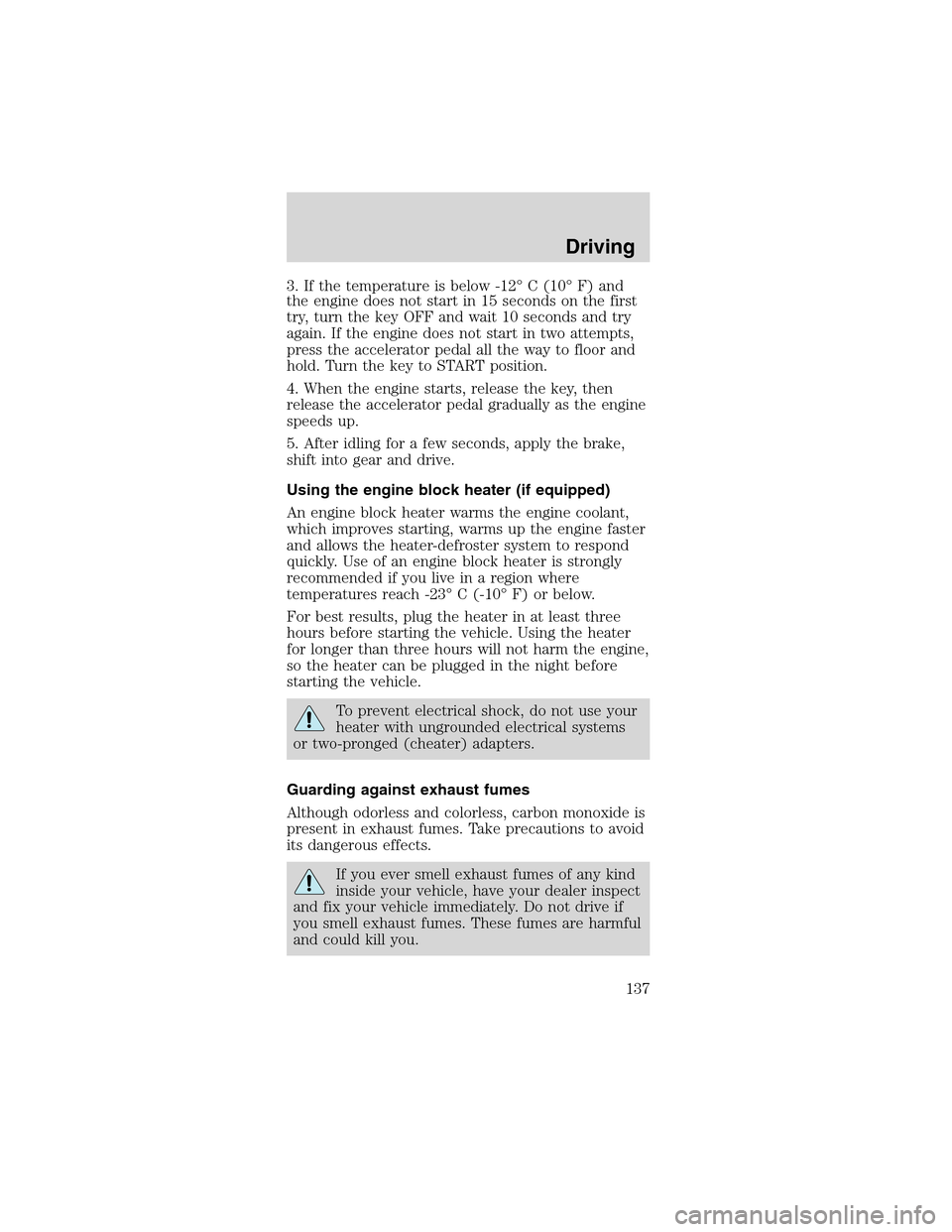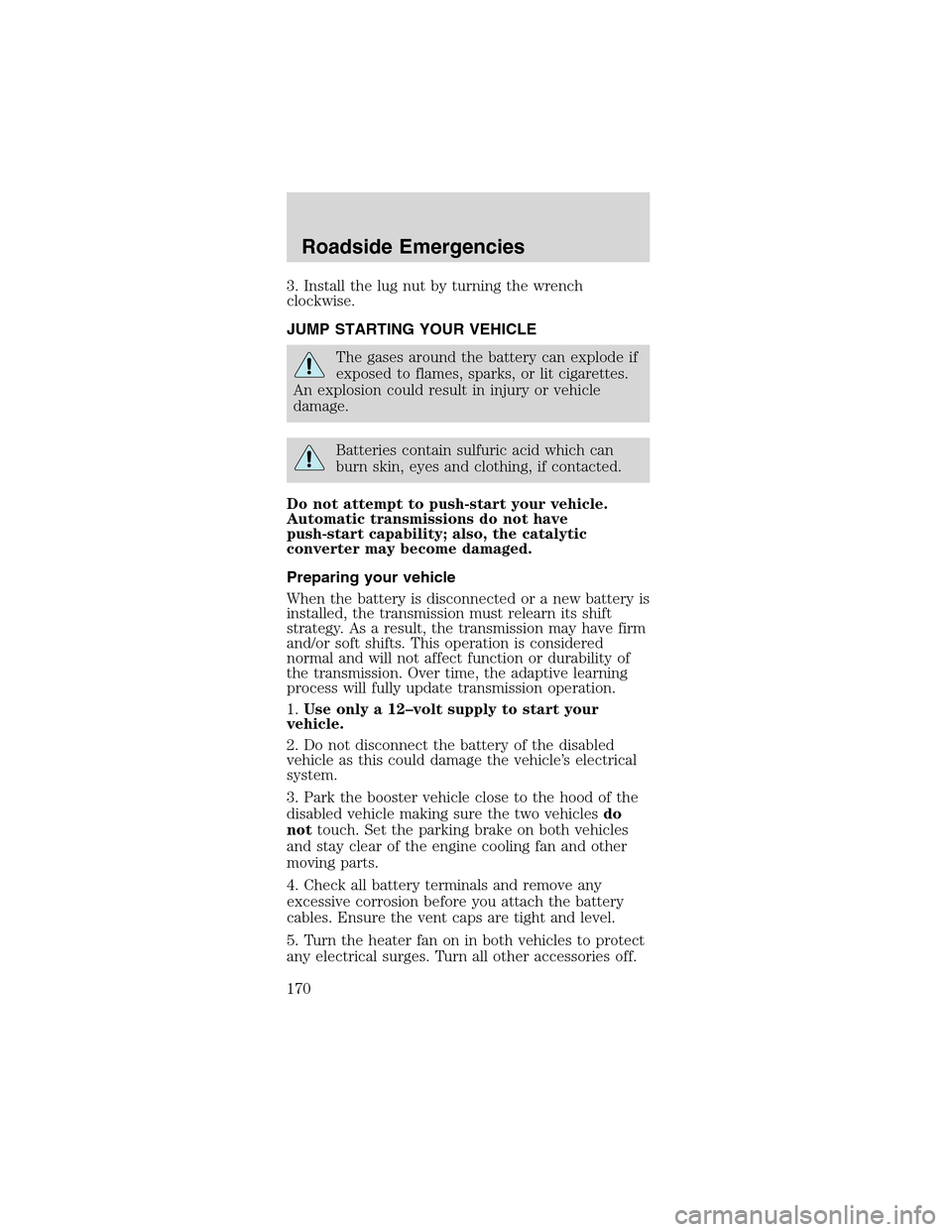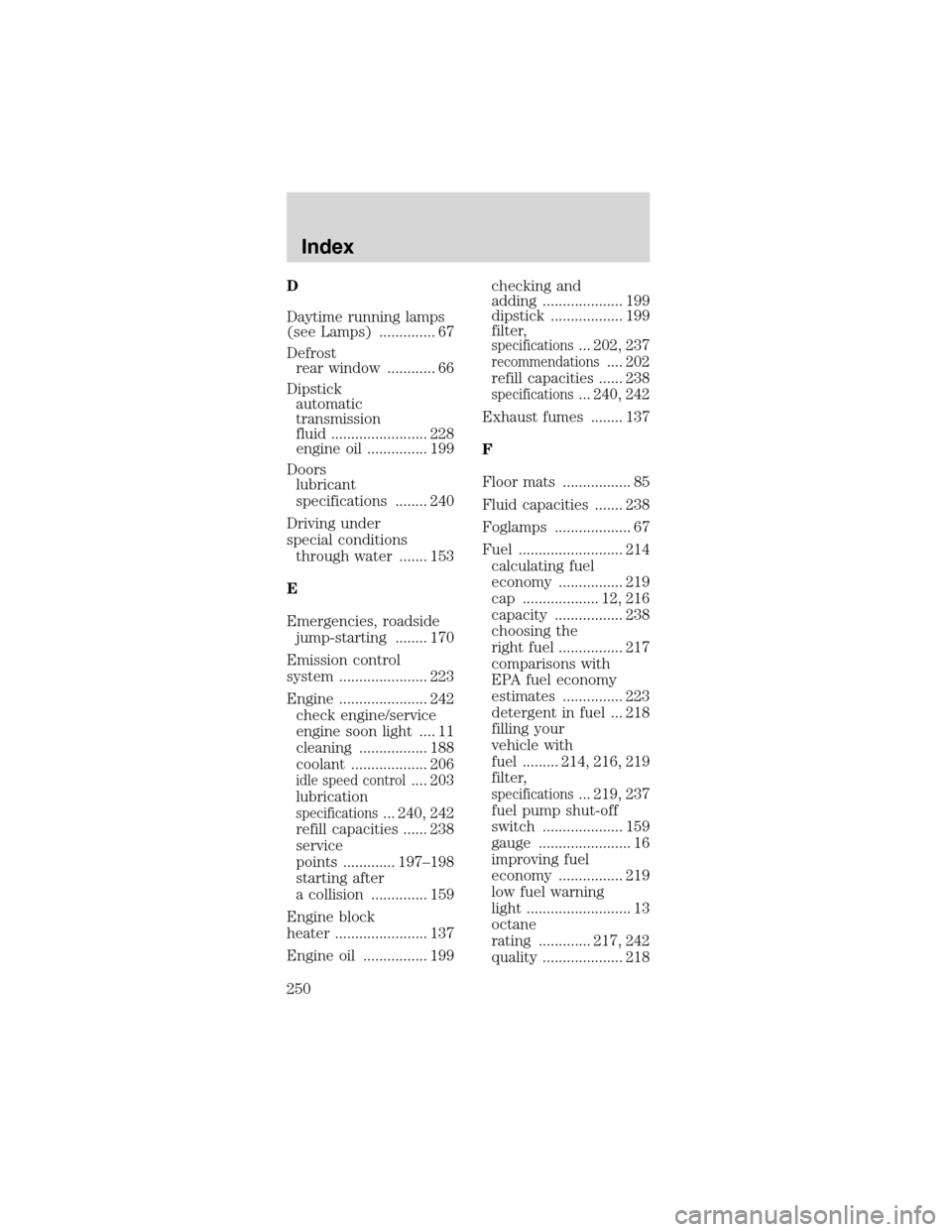Page 137 of 256

3. If the temperature is below -12°C (10°F) and
the engine does not start in 15 seconds on the first
try, turn the key OFF and wait 10 seconds and try
again. If the engine does not start in two attempts,
press the accelerator pedal all the way to floor and
hold. Turn the key to START position.
4. When the engine starts, release the key, then
release the accelerator pedal gradually as the engine
speeds up.
5. After idling for a few seconds, apply the brake,
shift into gear and drive.
Using the engine block heater (if equipped)
An engine block heater warms the engine coolant,
which improves starting, warms up the engine faster
and allows the heater-defroster system to respond
quickly. Use of an engine block heater is strongly
recommended if you live in a region where
temperatures reach -23°C (-10°F) or below.
For best results, plug the heater in at least three
hours before starting the vehicle. Using the heater
for longer than three hours will not harm the engine,
so the heater can be plugged in the night before
starting the vehicle.
To prevent electrical shock, do not use your
heater with ungrounded electrical systems
or two-pronged (cheater) adapters.
Guarding against exhaust fumes
Although odorless and colorless, carbon monoxide is
present in exhaust fumes. Take precautions to avoid
its dangerous effects.
If you ever smell exhaust fumes of any kind
inside your vehicle, have your dealer inspect
and fix your vehicle immediately. Do not drive if
you smell exhaust fumes. These fumes are harmful
and could kill you.
Driving
137
Page 170 of 256

3. Install the lug nut by turning the wrench
clockwise.
JUMP STARTING YOUR VEHICLE
The gases around the battery can explode if
exposed to flames, sparks, or lit cigarettes.
An explosion could result in injury or vehicle
damage.
Batteries contain sulfuric acid which can
burn skin, eyes and clothing, if contacted.
Do not attempt to push-start your vehicle.
Automatic transmissions do not have
push-start capability; also, the catalytic
converter may become damaged.
Preparing your vehicle
When the battery is disconnected or a new battery is
installed, the transmission must relearn its shift
strategy. As a result, the transmission may have firm
and/or soft shifts. This operation is considered
normal and will not affect function or durability of
the transmission. Over time, the adaptive learning
process will fully update transmission operation.
1.Use only a 12–volt supply to start your
vehicle.
2. Do not disconnect the battery of the disabled
vehicle as this could damage the vehicle’s electrical
system.
3. Park the booster vehicle close to the hood of the
disabled vehicle making sure the two vehiclesdo
nottouch. Set the parking brake on both vehicles
and stay clear of the engine cooling fan and other
moving parts.
4. Check all battery terminals and remove any
excessive corrosion before you attach the battery
cables. Ensure the vent caps are tight and level.
5. Turn the heater fan on in both vehicles to protect
any electrical surges. Turn all other accessories off.
Roadside Emergencies
170
Page 246 of 256
Dash trim
Electrochromic mirror with compass
Electrochromic mirror with compass and
temperature display
Engine block heaters
Remote keyless entry system
Remote start system
Travel equipment
Auto headlamps with daytime running lights (DRL)
Daytime running lights (DRL)
First aid kit
Fog lights
Highway safety kit
Removable luggage rack
Removable luggage rack adapters (Bike, ski,
snowboard)
Speed control
Protection and appearance equipment
All-weather vinyl floor mats
Car cover
Cargo liners, interior
Carpet floor mats
Door edge guards
Door sill scuff plates, stainless
Flat splash guards
Front end covers (full and mini)
Gearshift knob
Leather steering wheel
Molded splash guards
Pedal covers
Seat belt extenders
Accessories
246
Page 250 of 256

D
Daytime running lamps
(see Lamps) .............. 67
Defrost
rear window ............ 66
Dipstick
automatic
transmission
fluid ........................ 228
engine oil ............... 199
Doors
lubricant
specifications ........ 240
Driving under
special conditions
through water ....... 153
E
Emergencies, roadside
jump-starting ........ 170
Emission control
system ...................... 223
Engine ...................... 242
check engine/service
engine soon light .... 11
cleaning ................. 188
coolant ................... 206
idle speed control.... 203
lubrication
specifications... 240, 242
refill capacities ...... 238
service
points ............. 197–198
starting after
a collision .............. 159
Engine block
heater ....................... 137
Engine oil ................ 199checking and
adding .................... 199
dipstick .................. 199
filter,
specifications... 202, 237
recommendations.... 202
refill capacities ...... 238
specifications... 240, 242
Exhaust fumes ........ 137
F
Floor mats ................. 85
Fluid capacities ....... 238
Foglamps ................... 67
Fuel .......................... 214
calculating fuel
economy ................ 219
cap ................... 12, 216
capacity ................. 238
choosing the
right fuel ................ 217
comparisons with
EPA fuel economy
estimates ............... 223
detergent in fuel ... 218
filling your
vehicle with
fuel ......... 214, 216, 219
filter,
specifications... 219, 237
fuel pump shut-off
switch .................... 159
gauge ....................... 16
improving fuel
economy ................ 219
low fuel warning
light .......................... 13
octane
rating ............. 217, 242
quality .................... 218
Index
250